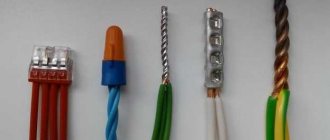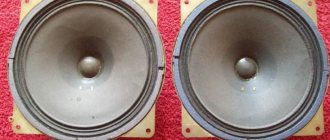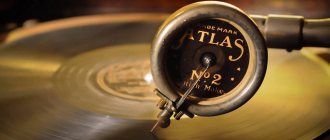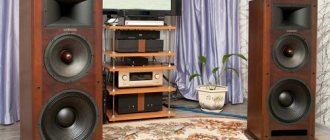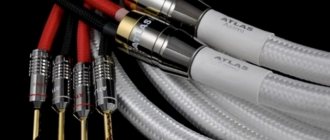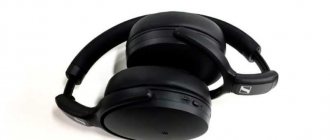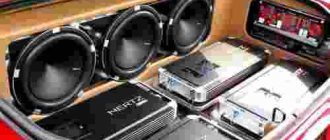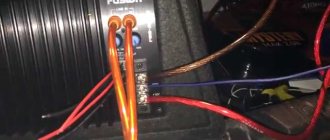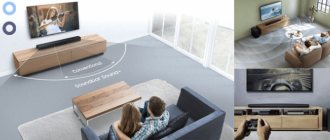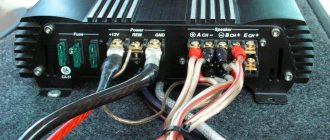Not only the sound quality, but also the reliability of the entire sound system depends on the choice of wires and connection of the speakers in the car. It is important to know which wire to use for the speakers. Any car audio system consists of several components. Depending on the level of difficulty, their number may vary. There must be a signal source, power amplifier and speakers. There may be several of them. These are front speakers, side speakers on car doors, rear speakers on the trunk lid and a subwoofer.
The opinion that it is enough to purchase high-quality sound equipment and your car will have great sound is wrong. Many people do not attach much importance to connecting cables for audio equipment, although they are ultimately responsible for the quality of sound reproduction.
Which wires are best to use for car speakers?
Most car enthusiasts do not know what wires are needed for speakers, although the principle of choice is quite simple. All cables that are used in a car to connect audio equipment are divided into three groups:
- Power
- Interblock
- Acoustic
Power cables are designed to supply power from the car battery to the amplifier, since the music center is already connected by standard cabling. In order to determine the cross-section of the power wire, it is enough to calculate the total power of the sound system and divide this value by the voltage of the vehicle's on-board network in accordance with the formula I=P/U. The result is the current consumed.
For an amplifier with 4 channels of 40 watts each, this value will be equal to 24 amperes. 40*4*2=24. You need to multiply by two, since 40 watts is the rated power. Next, you need to take into account the distance from the battery to the amplifier. With a cable length of 3-4 meters, its cross-section should be at least 8.0 mm2. Interconnect cables come in two types. This is a twisted pair wire or coaxial cable with a central core and metal braid. The best results will be obtained using double-shielded copper coaxial cable. Very important elements of the sound system are the wires running from the amplifier to the speakers.
Cable for warning systems: standards, requirements
The requirements that wires and cables used in the installation of warning systems must meet are formulated in two regulatory documents:
- In Federal Law No. 123-F3, which regulates the technical aspects of fire prevention measures;
- In the set of rules SP 3.13130.2009, relating to the arrangement of SOUE and intended for use in drawing up technical specifications and designing such systems.
Contents of Article 82 of the Federal Law and paragraph 3.4. the mentioned set of rules regarding the requirements for wires and cables for the warning system are almost identical.
Both documents indicate that the cable for the fire alarm system must remain functional for the entire time necessary to completely evacuate people from a burning facility.
Please note that there are no specific requirements for the use of cables of certain brands or properties.
The brands of cables and the conditions for their installation are determined during the design of the system, and if the project proves that the choice of installation method and the corresponding protection allow the use of a general-purpose cable, this is acceptable. However, in most cases, cables with the indices ng-FRLS and ng-FRHF with the required fire resistance time are still used.
Wires for car speakers
Wires for car audio speakers are selected according to several parameters. This is the conductor material, insulation type and cross-section. Speaker cables are made from several types of materials:
- Silver
- Copper
- Aluminum
In terms of the quality of transmission of an alternating audio frequency signal, a connecting cable made of pure silver is the undisputed leader. It has minimal resistance, does not oxidize and does not introduce significant distortion. It is rarely used in cars due to its high price. Cables made of copper coated with a thin layer of silver give good sound, with a slight increase in high frequencies. Pure oxygen-free copper is the main material for connecting cables to speaker systems. These wires are used most often. Wires for connecting aluminum speakers have higher resistance, which affects the quality of signal transmission. In addition, aluminum oxidizes faster and is more brittle, which can make it difficult to install inside the car. Copper-coated aluminum cables are somewhat better in quality, but in any case worse than copper wires.
Physical characteristics of an audio cable that affect sound reproduction quality
Let's consider the degree to which the quality of an audio cable is influenced by the purity of the copper core, skin effect, braided shielding, roughness, core coating and insulation.
Effect of copper purity on the audio signal
According to GOST 859-2001, copper with a purity of more than 99% is used for the manufacture of cable wires, in which the maximum proportion of impurities in the worst case does not exceed 1%, which practically does not affect its conductivity.
| Table of purity of electrical grades of copper | ||||||||||
| Copper grade | M00 | M0 | M0b | M1 | M1r | M2 | M2r | M3 | M3r | M4 |
| Copper content,% | 99,99 | 99,95 | 99,97 | 99,00 | 99,00 | 99,70 | 99,70 | 99,50 | 99,50 | 99,00 |
The oxygen present in copper has a valve effect and works like a diode, rectifying a sine wave. In oxygen-free copper of grade M0, the amount of oxygen does not exceed 0.001%. In the deoxidized M1 grade it is 0.01%, which theoretically can add nonlinear distortions to the audio signal by no more than this amount.
In practice, the introduced distortion is many times less, since the diodes are shunted with pure copper. Thus, the presence of oxygen in copper does not affect the natural sound.
For reference. Scientists V. M. Bolshov and V. I. Gukin found that the human ear does not detect nonlinear distortions of less than 3%.
Influence of the skin effect
When alternating current passes through a conductor, an alternating electromagnetic field appears around it, which creates an electric induction field that interacts nonlinearly with the electromagnetic field. As a result, the current density from the center of the wire axis shifts to its surface. This behavior of alternating current is called the skin effect.
The skin effect begins to appear at frequencies above 100 Hz in wires with a cross-section of more than 0.75 mm2. Thus, low frequencies (bass) are not affected. As the frequency increases, a smooth manifestation of the skin effect begins, and at a frequency of 20 kHz, the loss increases to 0.25 dB, which is almost impossible to notice. But even if you have perfect hearing, you can always compensate for losses in the high-frequency range using an equalizer.
On wires with a cross section of less than 0.75 mm2, there is no skin effect in the audio range. Therefore, to obtain a cable without skin effect for connecting audio speakers to an amplifier, for example, with a cross-section of 1.5 mm2, it is enough to twist two insulated wires with a cross-section of 0.75 mm2. Many audio cable manufacturers do this.
About braided cable shielding
The non-ferrous metal shielding used in expensive audio cables does not protect against low-frequency electromagnetic fields, and high-frequency fields, from which shielding can protect, under normal conditions create an EMF in the cable wires of several microvolts.
The level of influence of such a field is hundredths of a dB, which is impossible to hear even when the signal is not sent to the speakers.
About the number of cores and their diameter in the wires of an acoustic cable
The number and cross-section of cores in the cable wires does not affect the sound quality. The more cores and the smaller their diameter, the more elastic the cable will be. The question is relevant if you need to frequently transport the audio system and twist the cable.
Effect of roughness and coating of cable wires
According to Ohm's Law, the current strength in a closed circuit depends only on its resistance, therefore even greater roughness of the wires will reduce the cross-section of the wire by 0.1%, which will have no practical effect.
Coating wires with noble metals is justified only to reduce the influence of the skin effect at frequencies above 100 kHz. Therefore, it does not matter for an audio cable. The insulating coating does a good job of protecting copper from external influences. It may be justified to cover only the terminals at the ends of the wires.
Influence of cable wire insulation material
Any electrical wires, including those for connecting sound speakers, are covered with insulation to protect against short circuits and external environmental influences. The insulation is made of dielectric material and does not take part in the passage of current through the cable. Since the voltage supplied from the amplifier to the speakers does not exceed hundreds of volts, the insulation material does not matter.
Conclusion
The quality of an acoustic cable is determined only by its cross-section.
The purity and structure of copper crystals, the outer coating of the wires, the twist pitch, the cross-section of cores in the wire and their number, the insulation material - have virtually no effect on the natural reproduction of musical works.
If the cross-section of the wires is insufficient, part of the power will be dissipated on them and at moments of maximum volume, low frequencies (bass) will sound without distortion, but somewhat quieter, because they account for more than 70% of the total sound power.
Wires for car audio speakers
The wire for car speakers is a flexible multi-core cable with copper cores and polymer insulation. Polyvinyl chloride (PVC) or polypropylene foam is most often used as an insulating coating. The highest quality connecting cable is a product with Teflon insulation. The most important thing when choosing a cable for speakers is to correctly determine its cross-section. It is believed that the most common cable for car speakers with a cross-section of 2.5 mm2 ensures normal operation of a four-channel amplifier with front and rear speakers. To reproduce sound with satisfactory quality, this cross-section is suitable, but in order to obtain high-quality sound, the cross-section should be at least doubled. This is noticeable even by ear, especially when connecting speakers that are 3-4 meters away from the amplifier.
Factors influencing the natural sound of an audio system
It is worth noting that the speaker cable is the penultimate link in the chain, which affects the sound quality.
If at least one of the devices in the chain - the signal source, amplifier, cables or speakers does not provide Hi-Fi according to its characteristics, then the parameters of other devices will not matter.
The performance of the entire audio system will be determined by the device with the worst technical characteristics.
In conclusion, about the most important thing - the room for listening to music. Even with the best Hi-Fi or even Hi-End sound-reproducing equipment at your disposal, it is impossible to achieve natural sound in a room not suitable for these purposes.
Sound travels in waves due to changes in air density by the speaker at a speed of 334 meters per second, just like light waves. A sound wave is reflected from solid surfaces, like a light beam from mirror surfaces, but is well absorbed by porous surfaces.
If the audio system is placed in a room in which most of the surfaces are hard (walls, floors, ceilings, furniture), then phenomena such as reverberation (echo in the mountains), resonant waves (modes), axial resonances occur, which create peaks and dips in the frequency response sound signal emitted by the speakers.
Thus, it is impossible to obtain natural sound in rooms, even large ones, in which most of the surfaces are hard, without covering them with sound-absorbing material.
Therefore, before purchasing expensive audio equipment, you should think about whether the room in which you plan to place it is suitable.
I'm always surprised by discussions about sound quality in a car. Half the interior of a car with a volume of a couple of cubic meters consists of windshields and plastic panels that perfectly reflect sound waves. Therefore, by definition, sound inside a car cannot be natural. Any Chinese audio system in a car will work with the same success as a branded one at a price ten times more expensive.
The same applies to the premises in the apartment. Sound reproduction can be significantly improved if upholstered furniture is installed in the room, the walls and floors are covered with carpets, and the windows are hung with thick curtains.
True audiophiles and music lovers know this, and to enjoy natural sound they go to a concert hall or opera house, where the whisper of the artist on stage can be heard without amplification anywhere in the hall.
Wire for speakers in column
An important part of getting high-quality sound is connecting cables to the amplifier and speakers. The speaker wire in your car can be connected in several ways. Typically, a wire clamp under a washer and nut is used, or ready-made cables with RCA or “tulip” connectors are used. Often the stripped wire is pressed into a flat petal-type contact. When clamping a stripped wire, it must be thoroughly tinned so that the copper at the junction does not oxidize. The use of ready-made cables is complicated by the fact that they are produced at a certain length and it can be difficult to route the cables as needed for the configuration of the sound system.
CI Properties Table
| EC type | Composition of protection | Notes |
| Foil | Copper/aluminum | The foil completely protects the conductors and also provides complete coverage. Disadvantage: susceptibility to mechanical damage, bending and turning. |
| Mesh braid | Copper, other metals | The most reliable form of shielding, but quite difficult to produce. Conductors are not covered 100 percent, as with foil protection, but 60-85 percent (rarely 95%). They cost significantly more. |
| Spiral braid | Copper, other metal | Provides higher performance in terms of flexibility compared to other types of EC. There are no advantages in other parameters. Covers up to 80% of conductor area. |
| Dual screen | Copper, aluminum, other metals | It is a combination of braid and foil |
Features of EC
When constructing an AC circuit using EC, knowledge of the features of this cable is very important. Let us note an interesting fact. The word "shielded" is borrowed from the English language, where it means not only "screen" but also "protection." To be precise, in Western terminology it is customary to distinguish between Screened wire and Shielded wire, which is a combined type of EC (foil/braid).
Note. In addition, if the screen is laid on top of the wire in one layer, then it is designated by the letter F. If there are two layers on top of the conductor - S.
Design differences between screens
In addition to the main differences, the screens also differ structurally:
- The foil film is laid with the metal side inward and lengthwise. This implies laying a drainage conductor;
- The metal layer is turned outward (used with two layers of protection);
- The foil is laid overlapping and has a longitudinal seam.
Note. The drainage wire, which is provided in the design of the EC, is very important. It allows you to achieve greater reliability of the screen (additional protection is provided in case of accidental rupture of the foil).
